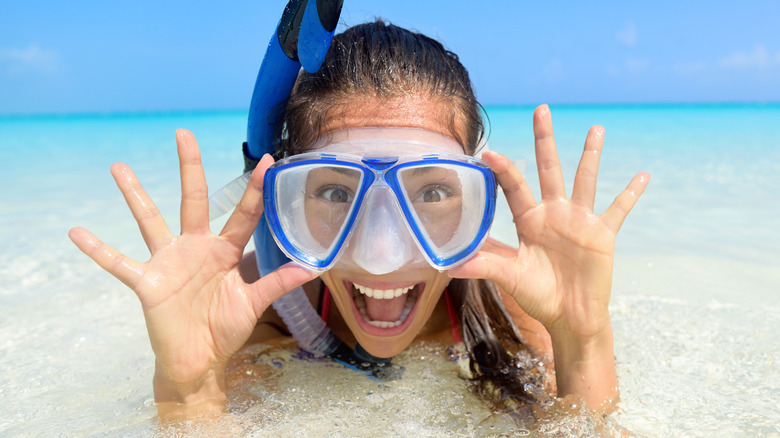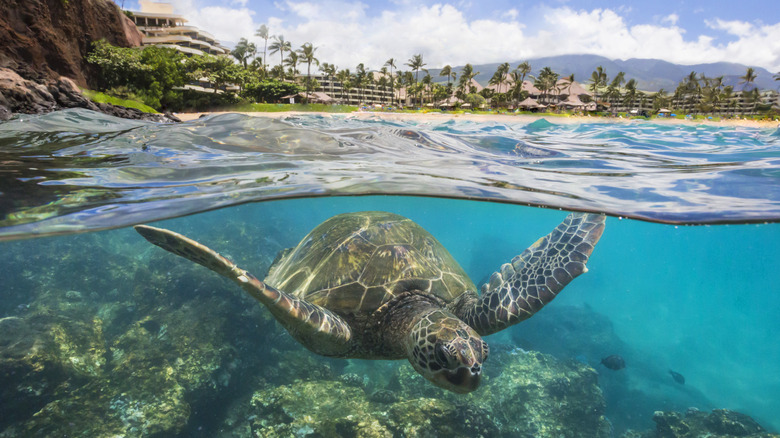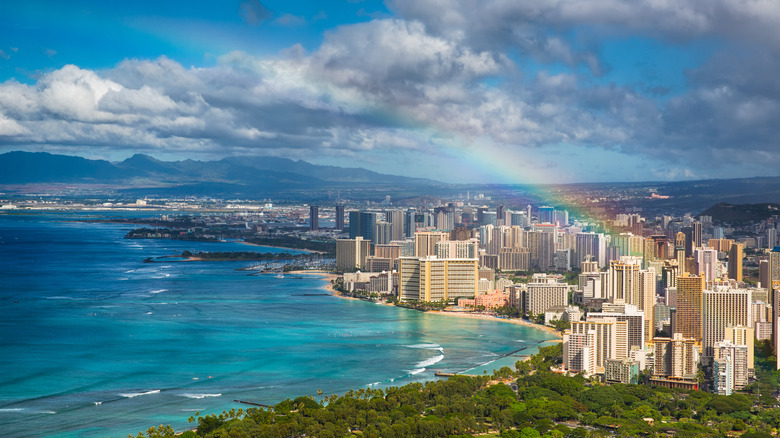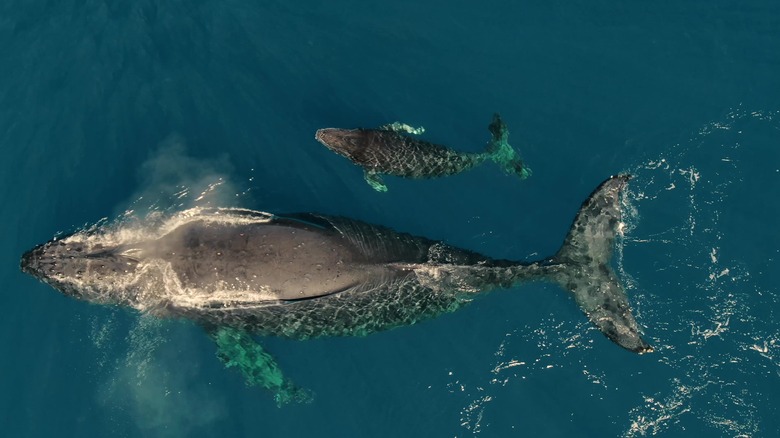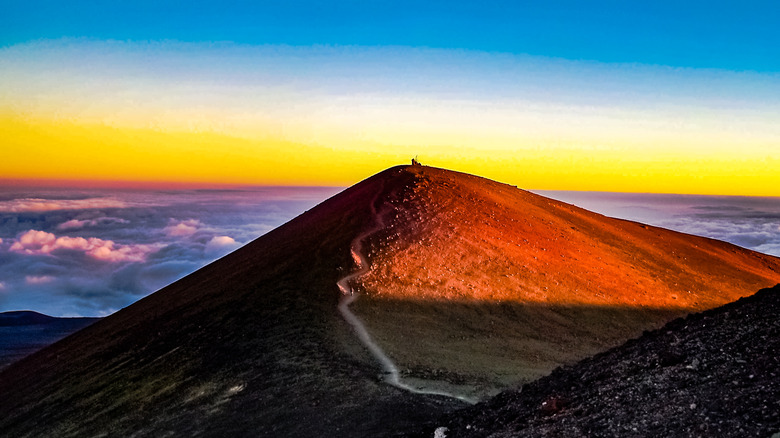The Best Times Of Year To Visit Hawaii For The Perfect Weather
Spending time in the Hawaiian islands gives you a chance to experience aloha; the word is commonly known to mean hello and goodbye, but it means more than that. According to Go Hawaii, it's "a concept of altruism and unity." It means feeling connected and loving to the world and those around you. One way that aloha can be expressed is by receiving a lei. Hawaiian Airlines, which is Hawaii's longest-running airline, can help arrange a lei greeting for visitors. You can also help show your love for the area by volunteering while you're in Hawaii and get a free night's hotel stay for your efforts.
But choosing where to spend your time in the Hawaiian Islands can be a challenge. Hawaii has six islands that you can visit, and they each have their own unique vibe. It admittedly takes a time commitment to get to Hawaii — it takes about 5-6 hours to fly to Hawaii from the West Coast of the US and around 11-12 hours from the East Coast if flying direct, per Hawaiian Airlines. So you'll probably want good weather while you're there. Here's what you need to know in terms of the weather to plan the perfect time of year for you to visit Hawaii.
Explore wants to acknowledge that Hawaii is the traditional territory of the Kānaka Maoli.
Hawaii's overall weather through the year is balmy
Hawaii visitors will be happy to know the idyllic sunshine and warm waters are pretty consistent throughout the islands year-round. The temperature, according to Hawaiian Airlines, averages 78 degrees Fahrenheit in winter and 85 degrees Fahrenheit in summer, and the water temperature at the beach averages 74 degrees Fahrenheit year-round. Trade winds frequently blow NE or ENE and bring the rain that makes the windward (north and east) sides of the islands particularly lush and green as compared to the leeward (south and west) sides. The winds are typically stronger in the winter, per Hawaii-Guide.
No matter what part of the island you're on or what time of year it is, you can get rain showers. Overall, it's more likely to rain from November to March. Hurricane season is from June to November, per KHON. But thankfully, the islands rarely get hit with hurricanes or big tropical storms, via USA Today.
While the weather is broadly consistent across the islands, diverse topography means there's a range of microclimates to consider. In fact, the Hawaiian Islands actually have most of the world's different climate classifications, per Hawai'i Magazine. Breaking it down by the three most visited islands and what you might want to do there can help you understand what you can expect weather-wise as well as what to pack for your beach vacation.
Oahu is perfect for both beginning surfers and experts
Oahu is the most visited island of Hawaii, according to Hawaii Guide. If you want bustling city life combined with beautiful beaches, don't miss out on the state's capital of Honolulu and its neighborhood, Waikiki. The historic Waikiki hotel, the Moana Surfrider, celebrated its 120th anniversary just last year. Waikiki is perfect for visitors because the mountains help block the rain, as noted by To-Hawaii.com. And Waikiki beach has got mellow waves, particularly in winter, making it the perfect time for beginning surfers to try out the sport there, per Sparky's Surf School. If you're planning to do anything out in deeper water in Oahu, like swimming with sharks with One Ocean Diving, remember that the winds and water will be the calmest in the early morning.
For those who aren't looking for calm water, nothing beats Oahu's North Shore. It's a winter destination for big-wave surfers. Storms regularly push big swells in, resulting in waves that can be 20 feet tall, per Shaka Guide.
Maui is the place to be for whale season
Maui is the second most visited Hawaiian island and the best place to be for whale season. Over 10,000 humpback whales (koholā in Hawaiian) come to the waters around Hawaii to mate, give birth, and raise young from around December through May per Go Hawaii. They frequent the shallow and narrow Auʻau Channel on the sunny and warm leeward side of Maui, and you can see them from shore. Sheraton Maui Resort & Spa on Kāʻanapali Beach even has a Kohola in Kaanapali package for peak whale season that comes with, among other things, binoculars for you to use from your room's lanai to watch the whales.
On Maui's wet windward side is another popular attraction. The drive along Hana Highway, aka the Road to Hana, has breathtaking waterfalls and flourishing forests. On the drive, expect to get rained on at some point no matter the time of year, according to Road to Hana, so bring a towel.
Maui also has its upcountry region at 1,700 to 4500 feet elevations. Upcountry is, according to Hawaii Ocean Project, cooler and less humid than the rest of the island. Upcountry includes the summit of the volcano Haleakalā, in the national park of the same name, which is sought after for amazing sunrise and stargazing views. You can expect the summit to be both potentially crowded and cold; it can get below freezing.
The Big Island has waterfalls and polar tundra
The island of Hawaii, commonly known as the Big Island, is the third most visited island in Hawaii, per Hawaii-Guide. It's the biggest island, as you might guess, and it has the most climate regions of the state, including a polar tundra region on the volcanic summits of the 13,803-foot tall Mauna Kea and the 13,678-foot Mauna Loa, according to Love Big Island. You can hike both, but you need to be in good shape and bring the right gear for the cold that will hit you the higher you go, even though you're in Hawaii. Because yes, it can and does snow in Hawaii on those peaks, per Sea Paradise.
Along the north and east coast of the Big Island, you'll get the opposite of snow with beautiful rainforests and amazing waterfalls that are generally at their most impressive during the winter thanks to the rains, per Love Big Island. It really solidifies Hawaii as one of the world's top 5 tropical destinations. On the western side of the Big Island is the sunny and dry Kona District, which includes the historic Kailua Village along the coast, and if you drive into the cooler and much cloudier uplands, you'll find world-renowned Kona coffee farms.
